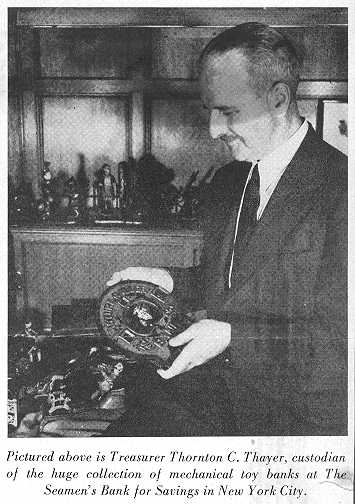TRUE MAGAZINE, February, 1946
A PENNY SAVED
By HORACE JOHNSON
 T
T
The facts of the case are that before any of the little brats could be persuaded to sink a penny in a bank, he or she had to be convinced that the immediate results were worth it. Talks of long-term investment meant nothing, and thrift as a virtue carried no more weight than the other virtues, Horatio Alger and Louisa May Alcott notwithstanding. To counteract this reluctance to save, there appeared about 1869 the first of the mechanical toy banks, and for the next thirty years the penny bank did everything but televise. Some, it is claimed, even encouraged thrift. Today these banks are collector’s items, either as works of art or as samples of mechanical ingenuity.
John Hall, a New England Yankee, is generally conceded to be the father of the mechanical toy bank. He noticed the reluctance with which a small boy deposited a penny in the slot of his clay bank, the only reward being a faint clank as it vanished forever from sight of man and the candy counter. Hall invented a little house, the chimney of which lifted up, revealing a little man seated at his desk. A penny placed on the desk provided just enough weight to counterbalance the chimney, and the little man disappeared with the coin, bowing his thanks as he descended into the bowels of the bank. This toy hit the market about 1869 and made an immediate hit. The kids banked their money if for no other reason than to see the little man nod his thanks.
But not for long. Competition jumped, and soon there were dozens of mechanical toy banks on the market. For the price of a penny saved, the inventor got a ringside seat at anything from a slugfest to a horse race. A penny placed on William Tell’s crossbow would shoot an apple from his son’s head, apple and penny disappearing into a slot in a castle. Reloading the crossbow with another coin would reset the apple. Another version had the hunter firing at a target on a tree, and as the coin shot home, a bear popped out of the tree stump, scaring the hunter into fits and inspiring the boy to dig up more pennies, not to buy a railroad but to see the bear do it again.
The horse race mechanical toy bank is a beautiful sample of inculcating young squirts with a strong sense of thrift. In this device, which appeared in 1871, two toy horses whirled around a circular track in response to a jerk on a string. The string, however, could not be jerked until a coin had been inserted to release a catch. The two horses spun freely on the ends of counterweighted arms, and the race was absolutely on the level, or was when it left the factory.
The little followers of Ben Franklin’s preachings would gather around the table under kerosene lamp and save their money, a penny a race, in the meantime betting their shirts off on the results.
Some toy banks stressed the educational angle. One elaborate piece of work featured an eagle feeding her two young. A penny placed in the eagle’s beak enabled the depositor to turn a lever, whereupon mama eagle flapped her wings, the eaglets flapped theirs, a squeeze box whistled bird cries of delight, and the penny dropped through a slot in the eagle’s nest.
In this contrivance for the furtherance of thrift and nature study there were some thirty separate castings, exclusive of the bolts, nuts, rivets and incidentals, and a glorious, hand-painted color job. It wholesaled at $8.50 the dozen, and retailed at $1 to $1.50 apiece. Today, the weight alone would bring nearly the same price when sold as ordinary scrap iron.
But it was in the realm of mayhem that the mechanical bank enjoyed its most spectacular success. A small boy would gladly save a penny to watch it make a horse throw its rider head first against a jagged stump. He took special delight in putting a coin in a cow’s back and watching the cow kick over the milkmaid, and saving money became practically hilarious when for one cent he could watch a dentist remove a huge, bloody tooth from a patient, both dentist and patient falling over backward at the drop of a coin.
Little girls could save a penny and watch a girl skip rope while bells rang an accompaniment, or she could give the coin to a monkey and watch it jump up on a hurdy-gurdy and hand the coin to the organ grinder. For really tough cases to crack, there was a Confectionery bank, operated by a mechanical storekeeper who took a penny with one hand and with the other produced a candy mint. In this way a thrifty mother could, for the price of a penny mint, induce her son to save a penny. Sometimes one wonders if it was worth it.
The mechanical banks went into a decline about 1890. There was a slight revival about the time of the Spanish-American War when a bank came out that permitted the depositor to fire a penny through a Yankee cannon and sink a Spanish ship, but after that their popularity fell off badly.
Though it is doubtful if the mechanical bank will ever return, its mark will always be with us. There is the pay phone, the juke box, the coin-box movie, vending machines and the pay toilet, all tracing directly or indirectly to the mechanical toy banks. You pays your money and you takes your choice, but never again will you be able to get your money’s worth, and still get your coin back.
